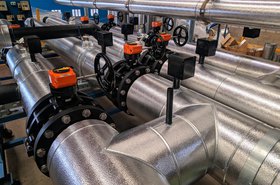As high-performance applications such as artificial intelligence (AI), machine learning (ML), 5G, edge computing and automated vehicles increase rapidly their process requirements, the cooling capacity of air is reaching its limitations. The cooling of IT equipment needs to increase its efficiency rapidly. It also needs to be planned to cope with the cooling capacity requirements over the coming years – future proof your current design.
Cooling accounts for approximately 40 percent of a data center’s total energy consumption. Keeping IT equipment, namely the chips, at their optimal operating temperature is mission critical. Present global economical and political conditions, such as the energy crisis, sustainability demands, supply chain issues and a shortage of skilled labor enormously effect operation and construction of digital infrastructure. It’s easy to see how the current climate faced by data center operators can quickly become a nightmare fodder for even the most level-headed IT professional.
According to the Uptime Institute, organizations that can’t handle these next-generation applications because of their cooling requirements, will compromise both their IT performance and efficiency, compared with those organizations that embrace them. So the pressure really is on operators to ensure their cooling systems are not only up to task, but operate as efficiently as possible, for as long as possible.
“All these buzz topics are causing the industry to innovate, and the data center vertical market must respond,” says Mark Bulmer, global head of data centers at GF Piping Systems. “AI, ML, VR, autonomous vehicles, Edge expansion, 5G adoption and beyond, these are all driving the IT equipment business and must be supported, powered and cooled in the white space.”
And with the world currently moving at break-neck speeds in terms of technological development, our insatiable appetite for data means there is resounding market demand for
capacity, efficiency and speed, driving the market to build bigger, better and faster than ever before.
Out with the old
As rack densities continue to increase alongside this trend, the industry’s air-cooling methods of old are no match for what’s to come, and in some cases, what’s already here. Although usually reserved for hyperscalers, the industry at large is now being forced to look beyond traditional air-cooling solutions to something not only more efficient, but more sustainable. Enter, direct liquid cooling (DLC).
Consisting of either cold-plate or immersion technology, there are currently six commercially available variants of DLC, with additional categories expected to develop in the near future.
“Hyperscalers, academia, medical research, the military – and anyone else running intense HPC applications – have been utilizing liquid cooling for years. Now, if you look at the market, many server manufacturers are offering a liquid cooled option in various form factors,” says Bulmer.
Bulmer goes on to explain that when it comes to measuring efficiency (via PUE) most new data centers are generally performing quite well. Colocation clients understand the need to improve PUE, and therefore efficiency, to the benefit of operating costs and carbon footprint. Indeed, the law in Germany now demands that data centers built from July 2026 operate with a maximum PUE of 1.5.
“From utility transformers to the rack, most operators can’t squeeze much more efficiency out of current technology in the areas of power distribution and building fenestration. That leaves mechanical systems.” The efficiency benefits possible using liquid cooling to air cooling are significant.
Liquid cooling and the transportation of coolants in critical environments is GF Piping’s forte. In its 220th year as a manufacturer, the company has years of experience in the data center market across all continents, providing owners and operators with leading edge plastic piping solutions.
The utilization of plastic not only helps speed up DLC deployments, but makes for a more efficient, reliable operation across the data center’s entire lifecycle. Plastic piping systems reduce the potential for corrosion enormously – reducing metallic content in coolant to virtually zero has huge reliability and safety benefits.
A long and happy life
When it comes to efficiency gains within a data center’s cooling applications, GF’s plastic piping systems can, on average, reduce energy costs by 25 percent, thanks to plastic having a lower thermal conductivity than its metal counterpart and far smoother internal bore, to reduce pressure losses.
Unlike metal, plastic can also be subjected to huge temperature deltas, while offering great chemical resistance, and virtually no biofilm buildup, making it the perfect choice for a data center environment. The lighter, more flexible material also accelerates installation by up to 50 percent, with less heavy lifting making for easier, safer handling for all involved.
Further contributing to a speedy installation, factory pre-insulation and preassembly not only ensures GF’s solutions are incredibly resistant to damage, but makes connections quicker via integrated electric welding, gluing, or plugging, depending on the application.
In terms of a long and happy life, the use of corrosion-free materials in GF’s plastic piping systems means that even after 25 years, there will be no degradation, nor will the system be impacted by the effects of UV radiation or other adverse weather conditions.
Over those same 25 years, operators can bask in the knowledge that their system will remain 100 percent maintenance free, while boasting a carbon dioxide balance that is 80 percent lower than that of metal systems. And in the interest of a circular economy, at the end of that long maintenance-free life, GF’s systems are fully recyclable.
Of course, before we get to that end of life, operators want the assurance that their IT equipment will perform at its best. Leveraging nearly 40 years of experience within the semiconductor market, GF Piping is uniquely positioned to provide DLC solutions that both operators and their customers can rely on.
Although DLC is a somewhat forgiving process, any impurities within the fluid can (and will) clog the system, impacting heat transfer at the energy source (chip), which will then affect performance. GF Piping Systems offers a complete plastic, or non-metallic, system. Commissioning is simple and speedy, thanks to the reduction of metal contact with coolant and reliability improved due to the lack of corrosion potential.
“Any opportunity to increase fluid purity is advantageous to the operator and the performance of the IT equipment. We are utilizing the design experience, materials and technologies that make GF a global leader in the microchip market to cool, unironically, microchips in the data center.
“We have cleanrooms strategically placed throughout the globe, to ensure clean assembly and manufacturing environments. Clean, highly quality controlled production for mission critical components, that will be in white space areas as part of a liquid cooling system, improves reliability and long-time performance of IT equipment” says Bulmer.
Quality and quantity
You often hear the phrase ‘quality over quantity’, but when it comes to building mission critical data centers (or retrofitting existing ones for that matter) you need both.
And you don’t get to guarantee 25 years of maintenance-free reliability without some pretty intensive quality control. GF Piping Systems has invested in its products – all 65,000 of them and counting – so that you can transfer that investment to your facility.
“From our standard COC process to saving batch samples from every manufacturing run, documentation and quality assurance are key points of our existence,” says Bulmer. “We have a full Center of Excellence dedicated just to this topic, that maintains everything from work process flows through to certifications, like our multi-site ISO 9001.”
And on the rare occasion things do go wrong with a product or system, GF Piping has access to multiple certified labs, equipped with tremendous testing capabilities to provide efficient root cause analysis, enabling corrective global action to be taken as required.
Of course, the best product in the world is no good if it doesn’t arrive on time, and with the Russia-Ukraine war still causing disruption to data center supply chains the world over, materials shortages and lengthy lead times have been wreaking havoc on ever-tightening construction schedules.
To mitigate this, GF Piping combines its global presence with extensive offsite manufacturing capabilities to provide pre-fabricated, modular solutions that afford the flexibility needed for a far leaner operation in terms of timeline.
All that said, a reliable, high-quality system, and an in-tact schedule aren’t the only pieces of the puzzle when it comes to a successful cooling project. The quality of the installation itself cannot be overstated.
“In every vertical, uptime is critical for our systems. Joint integrity and support, location and installation can literally make or break the system,” says Bulmer.
And once the system is in, while some might consider that to be ‘job done’, GF Piping offers client training and factory support, post installation, to help alleviate any installation issues, ensuring that the system provides reliable fluid transport for the entirety of its lifecycle.
Leave it to the professionals
It’s worth remembering that for most non-hyperscalers, DLC is a relatively new undertaking, therefore it makes sense to leverage any expertise that might be lacking, early on in the project.
When making the design transition from metal to plastic, pipe sizes may change slightly, which can affect everything from coil selection downstream, to valves and other hydronic components in the system.
Early involvement means GF can utilize its Advanced Engineering team to fine tune the piping system, which will positively influence both the upfront costs and the total cost of ownership.
“There are huge differences between metal and plastic, from how they're supported to how we control the expansion and contraction. So when we're advising, we look at everything from the hydronic side of things, so, what's the water flow pattern? To how we can work on the supports, and everything else that goes along with the piping system as a whole,” says Bulmer.
And with plants located in 34 countries, and 1,500 employees worldwide, GF Piping is able to provide each data center the same consistent level of global service, manufacturing, performance and expertise, anywhere in the world.
“We have the ability to replicate our solutions locally, leveraging our local subject matter experts, as well as in country assets who are familiar with local codes, regulations, norms, business trading practices, currency and all those sorts of things, to deliver similar products with slight deviations based on a customer’s regionality,” says Bulmer.
Future proof now
Despite a generally low uptake of DLC among the general data center populos at the moment, the Uptime Institute expects this to shift markedly in favor of DLC in the coming years, with nearly two-thirds of enterprise IT users citing they would consider it as a future option in a recent survey.
For now, it might be a hyperscalers game, but collectively, the data center industry considers the use of DLC to be not a question of if, but when and how much.
Rather than a challenge, the transition to direct liquid cooling should be seen as an opportunity to open the floor to rack densities that previously, SMEs could only dream of.
And the transition need not be instantaneous. With early involvement from experts like GF Piping, a collaborative approach can be taken for a gradual transition, following a roadmap that’s right sized for you and your application.
From design, to installation, to operation, GF Piping is able to provide a complete, turnkey solution that can be relied upon for years to come. Investing in long-lasting, environmentally friendly solutions that save on time, energy and manpower, operators can effectively arm their facilities against the myriad of seemingly unabating data center challenges they face today.
Regardless of how you approach the change, one thing is certain, a liquid future is coming and it will wait for no one. If you want to future-proof your facility, you need to future-proof your cooling system, now.
More from GF Piping...
-

Sustainable data center liquid cooling will need long-life plastic piping technology – GF Piping
Single-use plastics have been criticised for being environmentally harmful, but high-tech, long-lasting plastic technology in piping can enable energy efficient liquid cooling and much, much more
-

Sponsored Plastic fantastic: Significantly reducing data centers' energy bills
Why the inevitable shift to liquid cooling in data centers needn't be a pipe dream
-

Sponsored Tools of the trade
Demonstrating that a particular material is better for the environment than another might be hard, but new tools have been released proving the environmental advantages of plastic piping over metal



